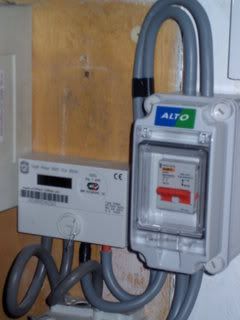Sigh, why are the jobs you do for relatives (at no cost) always turn out to be tricky!
Having sorted out the broken ring the kitchen fitters left, I'm now looking to replace the CU, and was checking for size, length of cables etc. today, when I noticed this little issue.
I had previously assumed that it was TN-S, as there is a main eathing clamp on the incoming cable (braided strap) (along with about 4 other equipotential bonding clamps ).
).
However, looking closer today, the braided strap from this clamp leads to a small henley type box beside the main incoming fuse enclosure, marked with an earth, and a cable leads from that inside the enclosure.
So my question is, is this a TN-S or a TN-C-S setup?
A pic will help I hope:

The 'main' earth point to the CU is currently on a clamp on the incoming cable, just below the connection for the braided strap you can see in the picture.
From what I can see, this appears to be a TN-C-S, with the earth coming out to a henley box, then going to the clamp on the incoming cable, then via the sheath to another clamp, then to the CU?!
Is it possibly a conversion from TN-S to TN-C-S that someone has muffed?
Or if it is TN-S is there a reason why an earth wire would be taken inside the main fuse enclosure? The only cables exiting that are the Phase and Neutral meter tails.....
Answers on a postcard please...
Cheers
Gavin
Having sorted out the broken ring the kitchen fitters left, I'm now looking to replace the CU, and was checking for size, length of cables etc. today, when I noticed this little issue.
I had previously assumed that it was TN-S, as there is a main eathing clamp on the incoming cable (braided strap) (along with about 4 other equipotential bonding clamps
However, looking closer today, the braided strap from this clamp leads to a small henley type box beside the main incoming fuse enclosure, marked with an earth, and a cable leads from that inside the enclosure.
So my question is, is this a TN-S or a TN-C-S setup?
A pic will help I hope:

The 'main' earth point to the CU is currently on a clamp on the incoming cable, just below the connection for the braided strap you can see in the picture.
From what I can see, this appears to be a TN-C-S, with the earth coming out to a henley box, then going to the clamp on the incoming cable, then via the sheath to another clamp, then to the CU?!
Is it possibly a conversion from TN-S to TN-C-S that someone has muffed?
Or if it is TN-S is there a reason why an earth wire would be taken inside the main fuse enclosure? The only cables exiting that are the Phase and Neutral meter tails.....
Answers on a postcard please...
Cheers
Gavin


